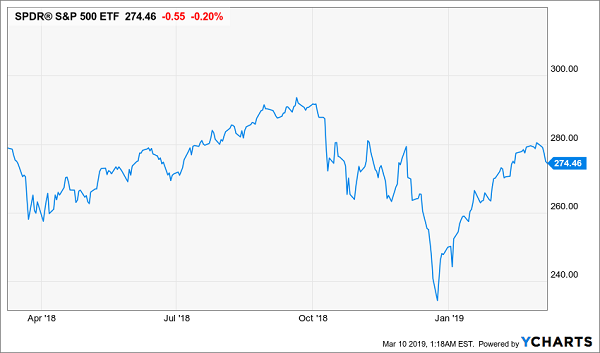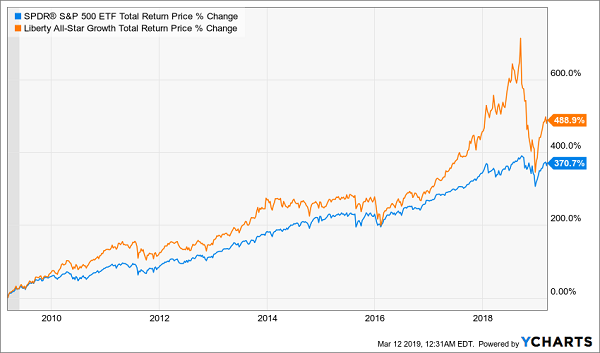Tune out the nervous Nellies panicking over last week’s job numbers: they missed the real news—and their panic has handed us a straight shot at a cheap 7.6% dividend today.
More on that opportunity shortly.
First, the real story here is that wages jumped 3.4% in February, which is the fastest rate in half a century. And the unemployment rate sits at 3.8%, far lower than just two years ago, when it levitated north of 4.8%.
A Direct Line From Paychecks to Profits
I’m sure I don’t have to tell you that consumers drive the economy, and more workers, making more cash, are great news for stocks. But Wall Street, distracted by the Chicken Little headlines, is still in a funk, as we can see by the performance of the SPDR S&P 500 ETF (SPY)—more on this fund below:
Stocks: Glass Half Empty

Despite stocks’ uptick since the start of 2019, they’re still far from 10-year highs, even though most companies posted revenue growth that beat expectations at the end of 2018.
This disconnect—stocks dipping, wages rising—slides open our buy window. Here are three ways to leap through, with far-and-away your best play, that bargain-basement 7.6% payer I mentioned off the top, bringing up the rear.
Strategy No. 1: Go With the Popular Name
An easy way to benefit from strong wage growth is to simply buy the SPDR S&P 500 ETF, which will track the market’s rise as richer consumers boost the economy.
But if you’re a regular subscriber to my dividend-obsessed CEF Insider service—whose portfolio yields 7.4%, on average—you know what I’m going to say next: SPY’s dividend is pathetic! With a 1.8% yield, it will give you just $18,000 in yearly income on a million bucks. That’s just a hair over the poverty level for a two-person household.
If you want to grab more of your return in cash (the only true way to protect your retirement from a market crash), you’ll need a lot more income.
Strategy No. 2: Buy a Sector ETF
Another way many folks would look to tap this trend is through the Consumer Discretionary ETF (XLY), which tracks the S&P 500 consumer-discretionary sector. Since this fund’s biggest holdings are Amazon (AMZN), Home Depot (HD) and McDonald’s (MCD), you’ll grab a piece of the action as consumers eat out more, buy online and upgrade their homes.
XLY isn’t even overbought, either: The fund is up 3.6% from a year ago, which is decent, and better than most S&P 500 sectors, but that gain is a shadow of the 11% annualized return the fund has put up over the last five years (when the consumer-discretionary sector was the second-best performer, behind technology’s 18% annualized return). This makes the sector attractive, since you’re getting strong companies whose shares are performing below their usual level.
Too bad XLY’s dividend is worse than that of SPY—just 1.2%. And while you are looking at price upside here, we demand much more of our return in cash in CEF Insider—and so should you.
Which brings me to your third (and best) play here:
Option 3: Buy This 7.6% Dividend for 8% Off
You can supercharge your income stream with a closed-end fund (CEF), namely the Liberty All-Star Growth Fund (ASG), whose 7.6% yield crushes what you’d get elsewhere; ASG holds discretionary favorites like Amazon (AMZN) and Visa (V).
Plus it’s cheap: its discount to NAV (or the difference between its market price and the value of its portfolio) stands at 7.8%.
The fund has also done a great job of beating the S&P 500’s performance over the last decade, with a near-500% return:
Beating the Market—in Cash

It’s tough to find this kind of growth with such a massive income stream, and in a market like the one we’re facing, that’s exactly what you want.
Why? Because you need equity exposure as the market continues to improve, but you also want to be able to access a percentage of that investment in the form of dividends in case you need cash but don’t want to sell during a downturn.
With growing volatility in recent weeks, despite the strong data, this combination of being invested in the market and being able to slowly receive cash payouts is exactly what we’re delivering in CEF Insider.
9.8% Dividends and Fast 20% Upside: Get Both Here
So what’s your best strategy for buying CEFs? It all comes back to that discount to NAV number I just showed you.
And it couldn’t be simpler: just wait till these funds’ discounts get absurdly wide, then strike. Once you’re in, sit back and collect your huge dividend checks while that discount vanishes—whipping the fund’s price higher.
I’ve seen this pattern repeat itself time and time again.
Here’s the best news: I’ve just released the names of 5 CEFs trading at even bigger discounts than ASG—and throwing off far higher dividends, too! Full details on all 5 are in my exclusive new Special Report. (You can grab your FREE copy now by clicking here.)
So what kind of dividends are we talking about? Sky-high payouts of 8.3%, on average. And 2 of these off-the-radar picks pay 9.0% and 9.8%!
I’ve been analyzing CEFs for years—I’m one of only a handful of analysts who dedicates 100% of their time to these unique funds—and I’ve come to just one conclusion:
If you want to build a portfolio that can keep your retirement income safe—and growing—through thick and thin, holding at least one or two of the 5 funds in this new report is a must.
Why?
Because in addition to their outsized cash dividends, these 5 funds are hard-wired to catapult us to 20%+ price gains when their discounts snap shut. Add it all up and you’re looking at a nearly 30% total return in the next 12 months here, with a big chunk of that in cash.
I’ve put everything you need to know about these 5 stealth funds in this unique Special Report—which is waiting for you now.
